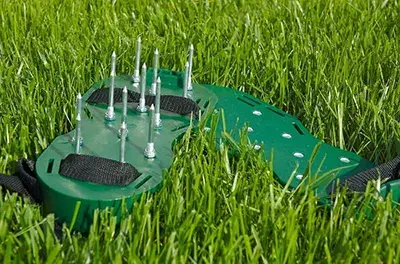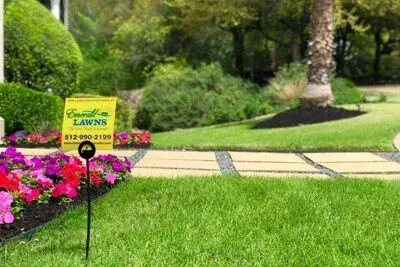Here are some common reasons behind brown lawn patches and the steps you can take to keep your lawn’s aesthetic consistent.
Why Do I Have a Brown Lawn?
In many cases, properties may see discoloration, wilting, and browning lawns because of extreme heat. However, the effects of heat damage are often widespread browning, especially in sun-exposed areas, giving the area a burned lawn appearance. On the other hand, sometimes patchy brown spots develop with mowing or watering issues.
Some of the most common causes of brown lawns include:
Lawn Disease
Texas’ warm and humid climate can make certain types of grass prone to fungal infection. Common infections such as brown patch, dollar spots, and rust can quickly spread to neighboring grass, resulting in wilting or thinning brown grass patches. Areas with high moisture and poor airflow are more prone to the spread of fungal infection.
Lawn Pest Issues
Untreated lawn pest issues are a common culprit behind various lawn issues, including brown lawns, and can infect or destroy turf in multiple ways. Chinch bugs release a toxin while they feed on grass that causes the turf in the area to repel water, wither, and die. Armyworms and grubs feed on large grass, leaving weakened and discolored patches.
Water Issues
Too much or too little water could be a cause of turf discoloration. As mentioned earlier, extreme heat can cause browning. A combination of heat, drought, and underwatering can also lead to parched and brown grass.

On the other hand, overwatering can also harm your lawn. Consistent wet soil can promote fungal growth if your grass type has shallow roots. If the soil is impacted and prevents airflow, parts of your lawn are susceptible to fungal growth. Frequent exposure to too much water can also lead to root rot, which can spread to nearby grass.
How To Treat Brown Lawns
Due to the different causes of brown lawns, various solutions exist to restore your lawn to its former glory. The best way to handle a damaged brown lawn is to let a professional inspect, diagnose, and treat your lawn. Some of the most common solutions used include the following:
Lawn Disease Treatment
If lawn disease is the culprit behind your brown lawn, taking swift action is essential. Begin by identifying the specific type of fungus affecting your lawn, as treatment methods may vary. Fungicides can be effective in controlling fungal infections.
However, once your lawn has been treated, there’s a risk of fungal infection returning if you don’t implement regular, proper lawn care practices. Steps such as aerating the soil and dethatching your lawn can improve airflow and reduce moisture levels, making your lawn less hospitable to disease-causing organisms.

Lawn Pest Control
Implement integrated lawn pest management strategies that minimize reliance on pesticides to combat lawn pest issues. This approach may include using beneficial nematodes to target grub populations or introducing natural predators to control insect populations. Regular lawn monitoring for signs of pest activity is crucial for early detection and intervention.
Water Management
Proper watering practices are essential for maintaining a vibrant, green lawn. Giving your lawn around one inch of water a week is a good rule of thumb. This can be difficult to estimate, so try watering your turf every few days and see how long it takes to show signs of being parched. In most cases, underwatering is better than overwatering.
To avoid forgetting when you’ve last watered your lawn, consider investing in a quality irrigation system with adjustable settings to ensure it receives adequate moisture without overdoing it. Water deeply and infrequently to encourage deep-root growth and resilience to drought conditions. You can also install rain sensors or smart irrigation controllers to optimize water usage and prevent wastage.
Achieve Green and Healthy Lawns with Emerald Lawns
You can breathe new life into your outdoor space by understanding the common reasons behind lawn discoloration and implementing appropriate treatment measures. The key is proactive and consistent care and maintenance. Give your Texas lawn the care it deserves to keep it vibrant and green—take action today to restore its glory and enjoy a lush landscape year-round.
At Emerald Lawns, we understand the value of well-maintained lawns in homes and businesses across Texas. Our services ensure your turf, trees, landscape, and other greenery receive top-quality lawn care from professionals who know how to keep your outdoor spaces healthy.
Get in touch with Emerald Lawns today and schedule a free evaluation of your property’s lawn.


.png?width=1142&height=1350&name=Holiday%20Decor%202025%20LP%20-%20548x648%20%20(1).png)


